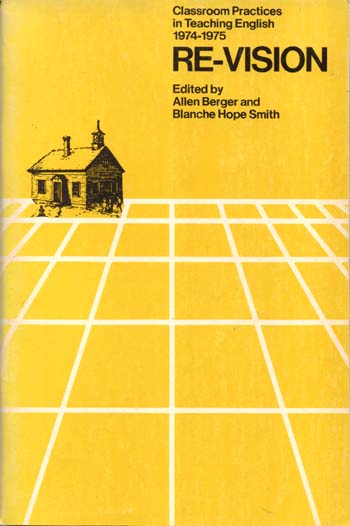|
Telling Book Covers (I) |
The subject is not as dull or self-evident as you might think. To begin with, there is the challenge that the topic poses for illustrators. How can you picture the humdrum comp classroom as interesting? And even when comp instruction moved to more adventurous locales, such as computer pods or senior citizens homes, there is the more basic problem of commensurability. Much of the activity of writing takes place inside the writer, and how can you picture that? Start with a frank example. In 1974 the National Council of Teachers of English published the twelfth volume in their series Classroom Practices in the Teaching of English. The topic of the volume was, loosely, "changes in classroom practices which came about through reflection on a particular problem" (p. vii). In other words the "re-vision" was in the teacher's head. Forty-five pieces are included, with topics ranging from composition to literature, from elementary grades to college, from bilingual students to videotape recorders. So why does the cover reproduce a nineteenth-century woodcut of a one-room schoolhouse? Outside two students fill a bucket at a water pump. Jack works the handle and Jill waits by the bucket (close-up). Is this an image of the old vision of instruction that will be re-visioned? If so, where is the image of the new vision? In truth, for decades the covers for many composition texts have connected writing instruction to past eras and fusty practices. The images indulge in a kind of antiquatization of the activity of teaching. If you were to tell these books by their covers, you would expect them to describe the teaching of writing not as revisionary but as reactionary. We will see more examples as our CompPanel series on book covers continues. In fact we have already seen an example in CompPanel 12, showing the cover of Edna Thomas 1955 Evaluating Student Themes crowded with a stylized figure depicting a nineteenth-century Sherlock Holmes detective with magnifying glass. But if you think recent book covers have foresworn the retro look, take a look at another example, from 2002. This is the cover to Stephen M. Fishman and Lucille McCarthy's fine study, Whose Goals? Whose Aspirations? Learning to Teach Underprepared Writers across the Curriculum (Utah State University Press). It is a current case-study of a philosophy teacher at the University of North Carolina Charlotte as he tries to find ways to reach three "underprepared" student writers, one a second-language speaker from India and the other two African Americans. Why then does the cover feature a photograph of students and teachers at private Oberlin College in 1906? Granted, Oberlin in 1835 became one of the first colleges in the United States to enroll African Americans, but the photograph of its students in 1906 seems to displace the central focus of Fishman and McCarthy, which is teaching students a century later. RH, September 2005 |
 Can
you tell a composition book by its cover? Are composition book covers
telling? This CompPanel is the first of a series that will scrutinize
book covers and dusk jacket illustrations in the publishing world of
composition teaching.
Can
you tell a composition book by its cover? Are composition book covers
telling? This CompPanel is the first of a series that will scrutinize
book covers and dusk jacket illustrations in the publishing world of
composition teaching.